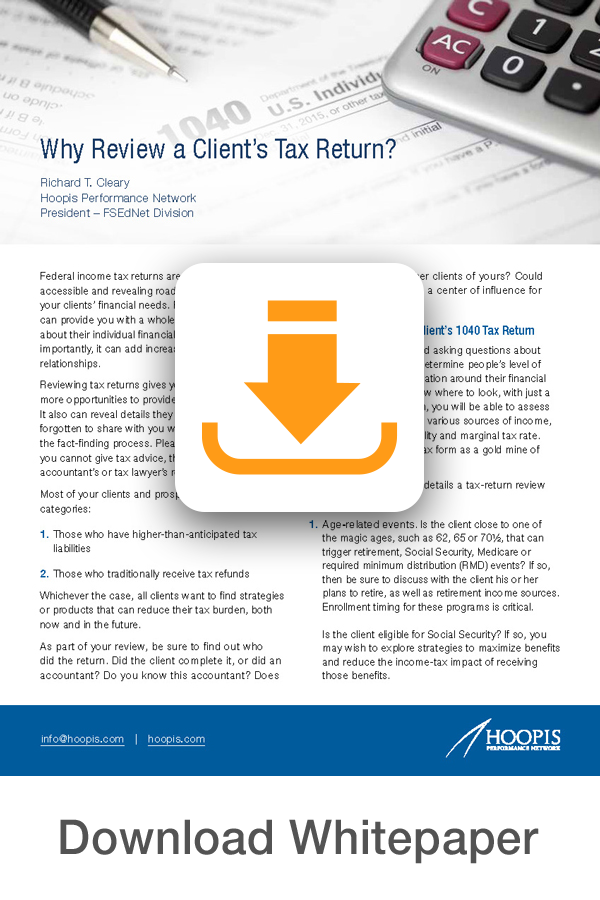Why Review a Client’s Tax Return?

Federal income tax returns are one of the most easily accessible and revealing road maps for determining your clients’ financial needs. Reviewing tax returns can provide you with a whole new level of insight about their individual financial situations. Even more importantly, it can add increased value to your client relationships.
Reviewing tax returns gives you the chance to identify more opportunities to provide value to your clients. It also can reveal details they may have failed or forgotten to share with you when you completed the fact-finding process. Please keep in mind that you cannot give tax advice, though. That is their accountant’s or tax lawyer’s responsibility.
Most of your clients and prospects will fall into two categories:
- Those who have higher-than-anticipated tax liabilities
- Those who traditionally receive tax refunds Whichever the case, all clients want to find strategies or products that can reduce their tax burden, both now and in the future.
As part of your review, be sure to find out who did the return. Did the client complete it, or did an accountant? Do you know this accountant? Does he or she deal with other clients of yours? Could the accountant become a center of influence for your practice?
What to Look for on a Client’s 1040 Tax Return
By reviewing a return, and asking questions about specific areas, you can determine people’s level of knowledge and sophistication around their financial situations. Once you know where to look, with just a glance of a current return, you will be able to assess a client’s earned income, various sources of income, business activity, tax liability and marginal tax rate. Think of a client’s 1040 tax form as a gold mine of information.
Here are some valuable details a tax-return review can reveal.
- Age-related events. Is the client close to one of the magic ages, such as 62, 65 or 70½, that can trigger retirement, Social Security, Medicare or required minimum distribution (RMD) events? If so, then be sure to discuss with the client his or her plans to retire, as well as retirement income sources. Enrollment timing for these programs is critical. Is the client eligible for Social Security? If so, you may wish to explore strategies to maximize benefits and reduce the income-tax impact of receiving those benefits. We must remain especially vigilant when working with widowed or divorced clients because they may be eligible for benefits based on someone else’s age or retirement status.
- Change in filing status. Has there been a change in the client’s tax filing status, caused by a recent divorce or marriage? Either will have tax and cashflow implications. Also, the client’s estate or life insurance coverage may have to be adjusted.
- Dependent-related issues. Looking at the client’s list of dependents can help you address any potential child education opportunities, such as a tax-advantaged 529 plan, and any concerns about elderly parents. A life insurance review may be needed to provide the family with sufficient income in the event of a death in the family.
- Employment status. The 1040 will also tell you whether the client is employed or self-employed. This most likely will lead to a discussion on retirement planning and reveal the client’s savings and contribution levels. You also may consider a review of the business entity and discuss the benefits, liabilities and risks of having a partnership, sole proprietorship or LLC. Does the client have a funded buy/sell in place?
As you review any return, use lines 7–22 on Form 1040 to get a handle on the taxpayer’s total income and all the income sources for the current year. This will enable you to project a client’s future income.
What to Look for on Federal Tax Schedules A–E
Don’t limit your review to just the 1040. You can gain a lot of additional insights into clients’ investments if you take the time to review Schedules A–E, too.
- Itemized deductions. On Schedule A, you will find a list of itemized medical expenses, which can allow you to move easily to a discussion about the client’s or family member’s general health, as well as his or her current insurance coverage and any long-termcare policies. 2. Intere st and dividend income. On Schedule B, you can quickly identify the client’s investments, which will easily move the conversation into how the client perceives his or her risk tolerance. This will give you insight into his or her views on diversification, as well as investment strategies and goals.
- Profit or loss from business. Sometimes, clients miss things that are obvious to you. For example, if your client is self-employed and filing Schedule C, look at the income and deductions. Did he or she maximize eligible retirement plan contributions?
- Capital gains or losses. On Schedule D, you will be able to see if the client carried over any capital losses that could have been used to offset gains.
- Rental and royalty income. And finally, on Schedule E, you will find information about the client’s investment income — was it made up of passive income or losses? From this information, you can discuss the different types of investments the client has, and their purposes, to gain insights into the client’s investment strategies. You also can find out if the client receives additional income from rental properties and royalties on published books, music and other creative works.
Yes, there are many excellent opportunities that will come up when you take the time to review your clients’ tax returns. Some will be quick and easy, such as recommending that they increase their 401(k) contributions. In other situations, it will take a little more thought and planning to develop an appropriate strategy. Examples include tax-advantaged investing, tax-deferral programs, charitable strategies, insurance sales and estate tax returns.
By getting into the habit of reviewing your clients’ tax returns each year, you will quickly be able to identify significant changes that have occurred and help them make appropriate adjustments to their finances to fit their current situations. This review does not have to take a lot of a client’s time. Simply go over the return before your meeting so that you can focus your client discussion on only the important issues.
This review might enable you to deepen your client relationships more than any strategy you’ve used.
Video Training for Advisors and Sales Leaders
Our brief training videos comprise an online library of resources that can supplement training for new reps, mid-career reps, veterans and staff members.
An effective resource for training financial advisors is Hoopis Performance Network, which features online, ondemand, total video-based training built on four Disciplines of Success with access to more than 400 sessions. The coursework can be either self-study or facilitator-led, and it complements any firm, agency or company training programs and marketing selling systems. Your advisors can access the video training anytime, anywhere, on their computers, smartphones or tablets. It’s a cost-effective, time-efficient way to increase productivity, thus retention.
An effective resource for training new or experienced sales leaders is HPN, an innovative virtual platform designed for financial leaders who are building a region, an agency or firm, a sales unit or a sales team. You can get access to hundreds of high-impact sessions for all levels of experience, divided into five distinct elements of success. These sessions are short and easily digestible, averaging less than 10 minutes. Your managers can access the video training anytime, anywhere, on their computers, smartphones or tablets.



